Enron's Corporate Failure: Issues with Mark-to-Market Accounting, Special Purpose Entities, and Stock Options
VerifiedAdded on 2023/06/05
|12
|2595
|453
AI Summary
The report identifies and discusses the issues presented in the case study of Enron in the academic article given. It explains and discusses the issues such as mark-to-market accounting, role of special purpose entities and use of stock options by Enron’s management to manipulate its stock results. The report also analyzes the different ways by which five elements of financial statements are being measured in US GAAP and IFRS.
Contribute Materials
Your contribution can guide someone’s learning journey. Share your
documents today.
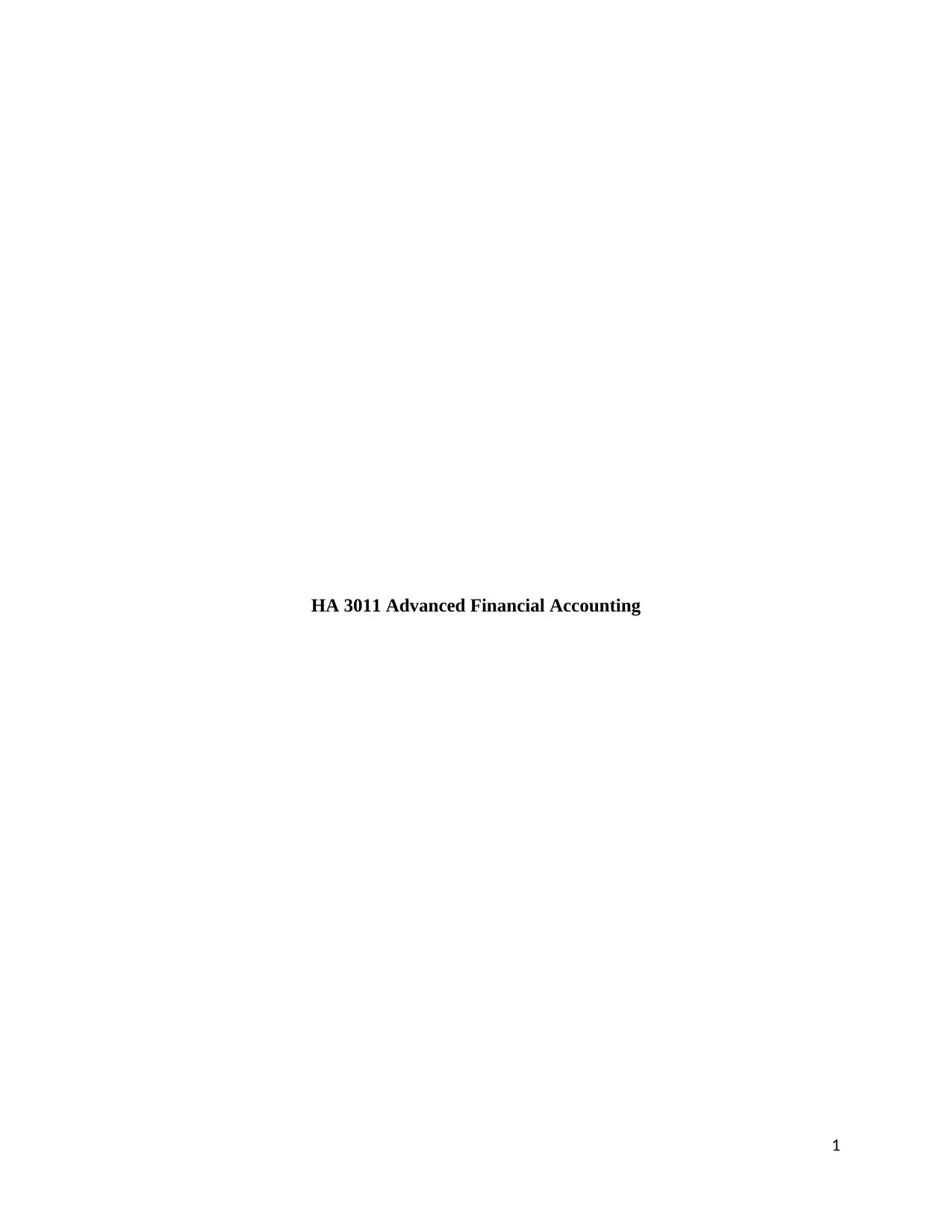
HA 3011 Advanced Financial Accounting
1
1
Secure Best Marks with AI Grader
Need help grading? Try our AI Grader for instant feedback on your assignments.
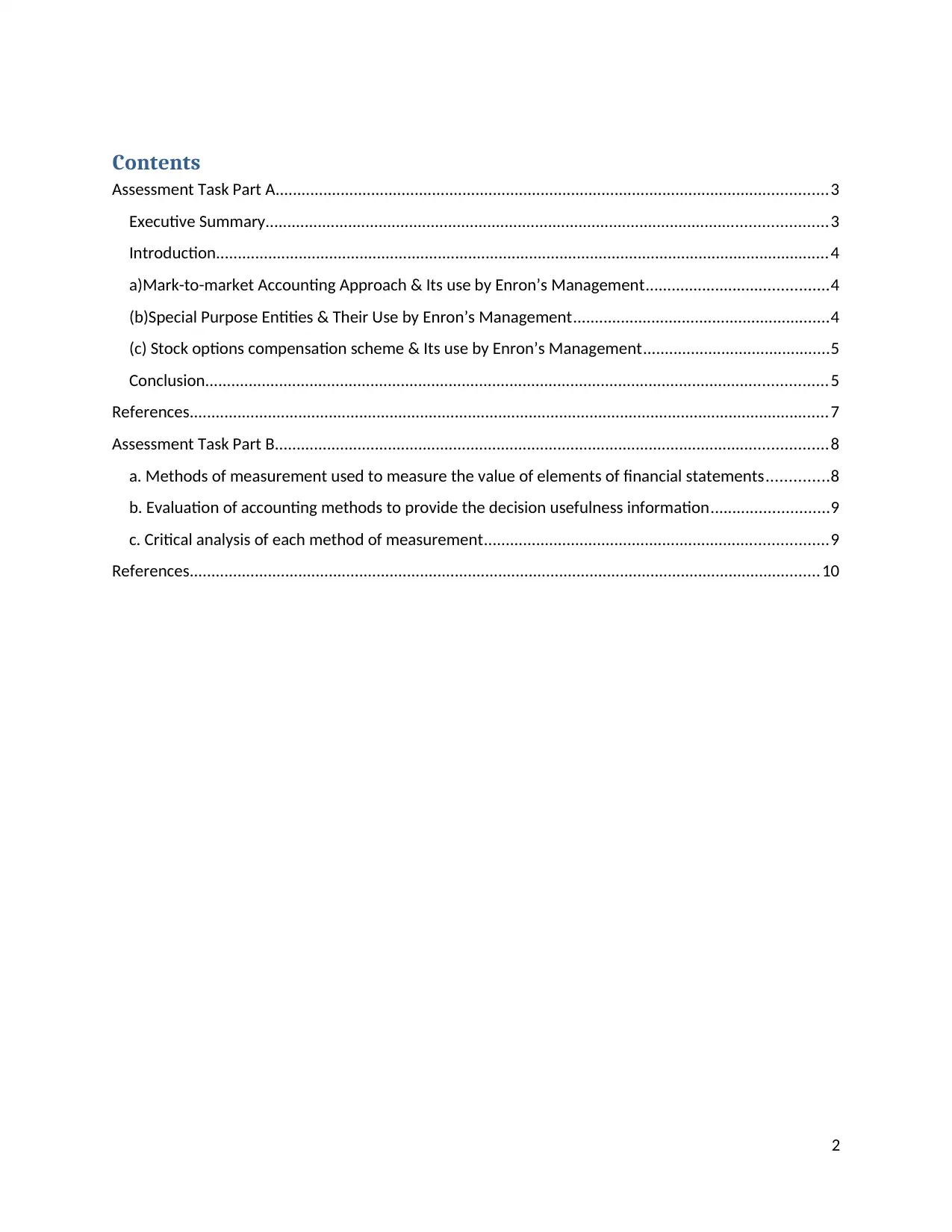
Contents
Assessment Task Part A...............................................................................................................................3
Executive Summary.................................................................................................................................3
Introduction.............................................................................................................................................4
a)Mark-to-market Accounting Approach & Its use by Enron’s Management..........................................4
(b)Special Purpose Entities & Their Use by Enron’s Management...........................................................4
(c) Stock options compensation scheme & Its use by Enron’s Management...........................................5
Conclusion...............................................................................................................................................5
References...................................................................................................................................................7
Assessment Task Part B...............................................................................................................................8
a. Methods of measurement used to measure the value of elements of financial statements..............8
b. Evaluation of accounting methods to provide the decision usefulness information...........................9
c. Critical analysis of each method of measurement...............................................................................9
References.................................................................................................................................................10
2
Assessment Task Part A...............................................................................................................................3
Executive Summary.................................................................................................................................3
Introduction.............................................................................................................................................4
a)Mark-to-market Accounting Approach & Its use by Enron’s Management..........................................4
(b)Special Purpose Entities & Their Use by Enron’s Management...........................................................4
(c) Stock options compensation scheme & Its use by Enron’s Management...........................................5
Conclusion...............................................................................................................................................5
References...................................................................................................................................................7
Assessment Task Part B...............................................................................................................................8
a. Methods of measurement used to measure the value of elements of financial statements..............8
b. Evaluation of accounting methods to provide the decision usefulness information...........................9
c. Critical analysis of each method of measurement...............................................................................9
References.................................................................................................................................................10
2
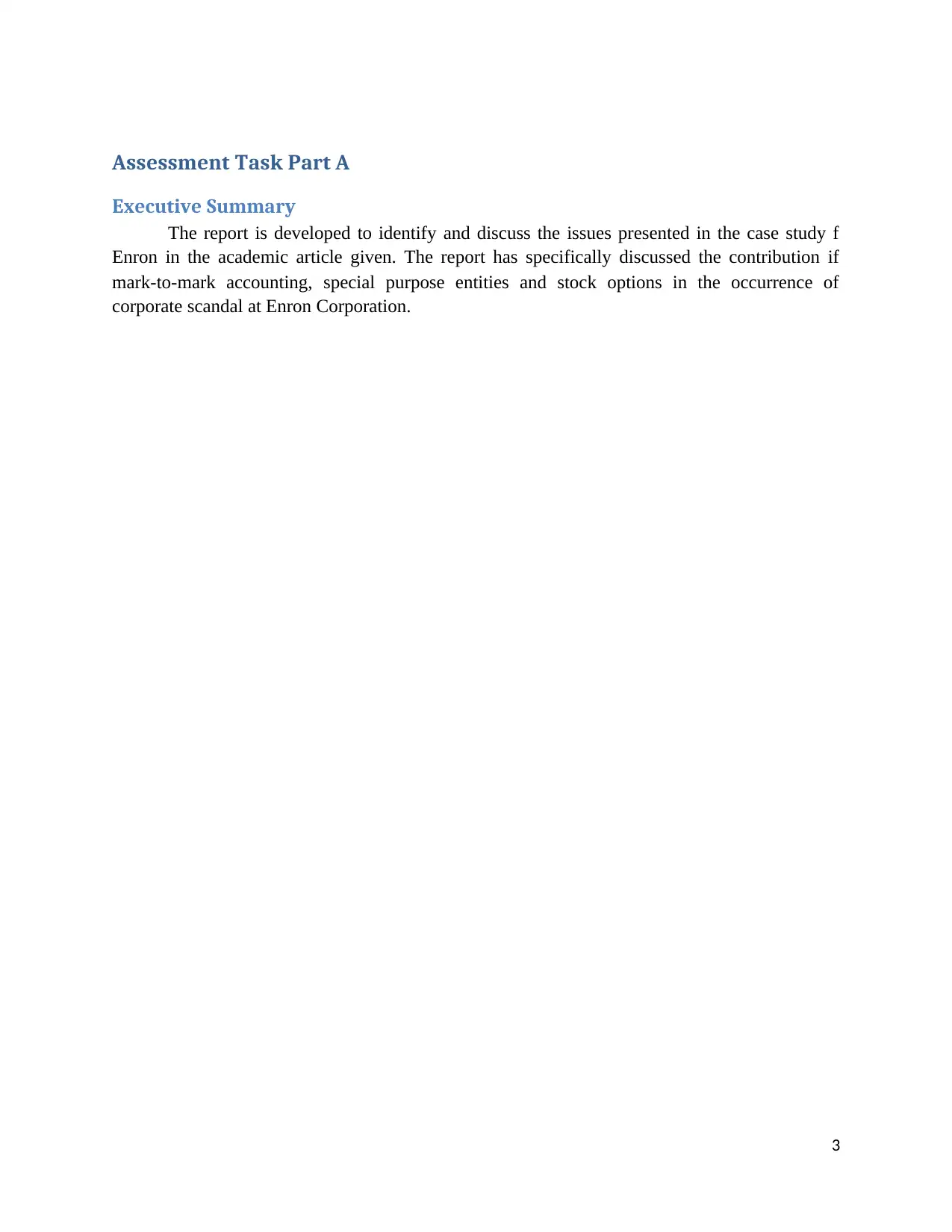
Assessment Task Part A
Executive Summary
The report is developed to identify and discuss the issues presented in the case study f
Enron in the academic article given. The report has specifically discussed the contribution if
mark-to-mark accounting, special purpose entities and stock options in the occurrence of
corporate scandal at Enron Corporation.
3
Executive Summary
The report is developed to identify and discuss the issues presented in the case study f
Enron in the academic article given. The report has specifically discussed the contribution if
mark-to-mark accounting, special purpose entities and stock options in the occurrence of
corporate scandal at Enron Corporation.
3
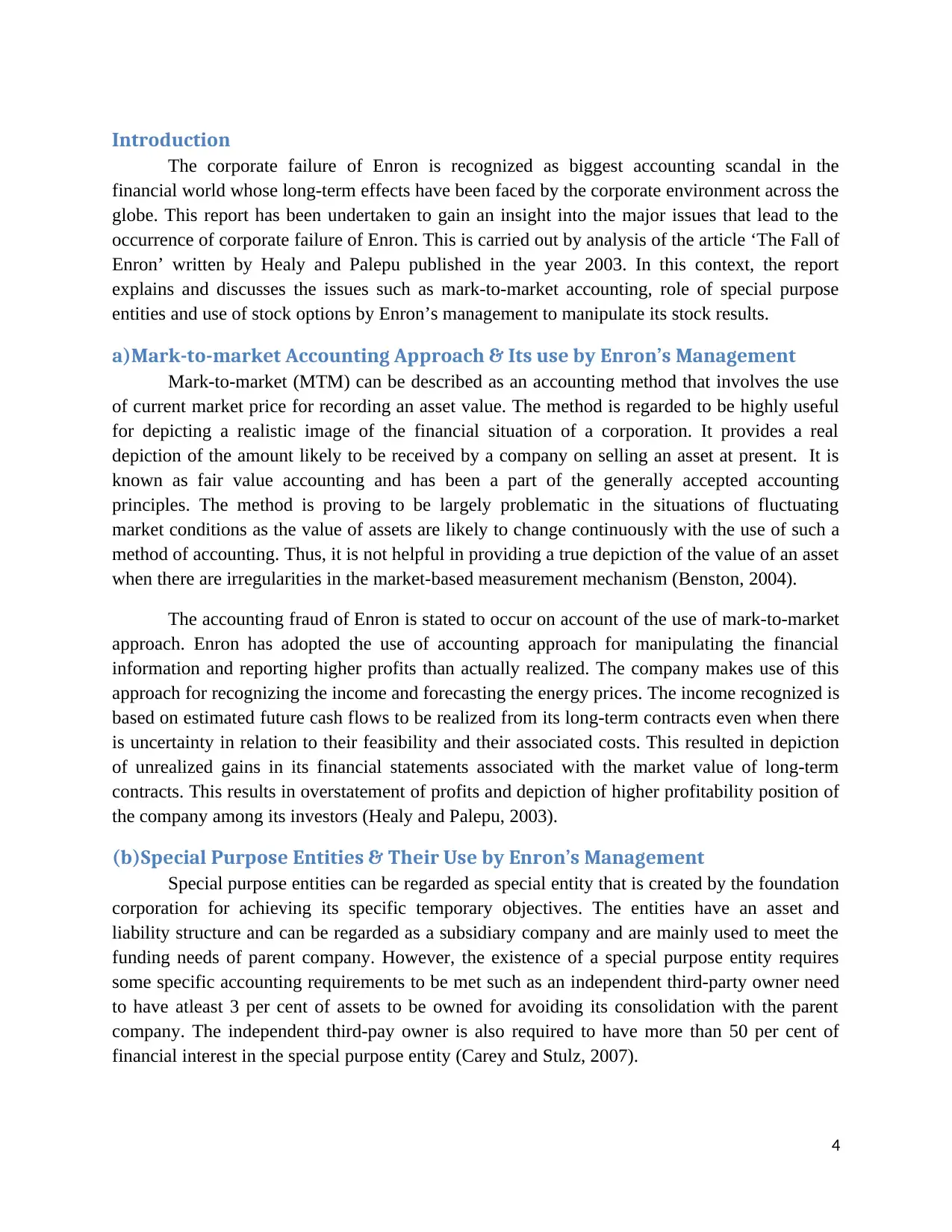
Introduction
The corporate failure of Enron is recognized as biggest accounting scandal in the
financial world whose long-term effects have been faced by the corporate environment across the
globe. This report has been undertaken to gain an insight into the major issues that lead to the
occurrence of corporate failure of Enron. This is carried out by analysis of the article ‘The Fall of
Enron’ written by Healy and Palepu published in the year 2003. In this context, the report
explains and discusses the issues such as mark-to-market accounting, role of special purpose
entities and use of stock options by Enron’s management to manipulate its stock results.
a)Mark-to-market Accounting Approach & Its use by Enron’s Management
Mark-to-market (MTM) can be described as an accounting method that involves the use
of current market price for recording an asset value. The method is regarded to be highly useful
for depicting a realistic image of the financial situation of a corporation. It provides a real
depiction of the amount likely to be received by a company on selling an asset at present. It is
known as fair value accounting and has been a part of the generally accepted accounting
principles. The method is proving to be largely problematic in the situations of fluctuating
market conditions as the value of assets are likely to change continuously with the use of such a
method of accounting. Thus, it is not helpful in providing a true depiction of the value of an asset
when there are irregularities in the market-based measurement mechanism (Benston, 2004).
The accounting fraud of Enron is stated to occur on account of the use of mark-to-market
approach. Enron has adopted the use of accounting approach for manipulating the financial
information and reporting higher profits than actually realized. The company makes use of this
approach for recognizing the income and forecasting the energy prices. The income recognized is
based on estimated future cash flows to be realized from its long-term contracts even when there
is uncertainty in relation to their feasibility and their associated costs. This resulted in depiction
of unrealized gains in its financial statements associated with the market value of long-term
contracts. This results in overstatement of profits and depiction of higher profitability position of
the company among its investors (Healy and Palepu, 2003).
(b)Special Purpose Entities & Their Use by Enron’s Management
Special purpose entities can be regarded as special entity that is created by the foundation
corporation for achieving its specific temporary objectives. The entities have an asset and
liability structure and can be regarded as a subsidiary company and are mainly used to meet the
funding needs of parent company. However, the existence of a special purpose entity requires
some specific accounting requirements to be met such as an independent third-party owner need
to have atleast 3 per cent of assets to be owned for avoiding its consolidation with the parent
company. The independent third-pay owner is also required to have more than 50 per cent of
financial interest in the special purpose entity (Carey and Stulz, 2007).
4
The corporate failure of Enron is recognized as biggest accounting scandal in the
financial world whose long-term effects have been faced by the corporate environment across the
globe. This report has been undertaken to gain an insight into the major issues that lead to the
occurrence of corporate failure of Enron. This is carried out by analysis of the article ‘The Fall of
Enron’ written by Healy and Palepu published in the year 2003. In this context, the report
explains and discusses the issues such as mark-to-market accounting, role of special purpose
entities and use of stock options by Enron’s management to manipulate its stock results.
a)Mark-to-market Accounting Approach & Its use by Enron’s Management
Mark-to-market (MTM) can be described as an accounting method that involves the use
of current market price for recording an asset value. The method is regarded to be highly useful
for depicting a realistic image of the financial situation of a corporation. It provides a real
depiction of the amount likely to be received by a company on selling an asset at present. It is
known as fair value accounting and has been a part of the generally accepted accounting
principles. The method is proving to be largely problematic in the situations of fluctuating
market conditions as the value of assets are likely to change continuously with the use of such a
method of accounting. Thus, it is not helpful in providing a true depiction of the value of an asset
when there are irregularities in the market-based measurement mechanism (Benston, 2004).
The accounting fraud of Enron is stated to occur on account of the use of mark-to-market
approach. Enron has adopted the use of accounting approach for manipulating the financial
information and reporting higher profits than actually realized. The company makes use of this
approach for recognizing the income and forecasting the energy prices. The income recognized is
based on estimated future cash flows to be realized from its long-term contracts even when there
is uncertainty in relation to their feasibility and their associated costs. This resulted in depiction
of unrealized gains in its financial statements associated with the market value of long-term
contracts. This results in overstatement of profits and depiction of higher profitability position of
the company among its investors (Healy and Palepu, 2003).
(b)Special Purpose Entities & Their Use by Enron’s Management
Special purpose entities can be regarded as special entity that is created by the foundation
corporation for achieving its specific temporary objectives. The entities have an asset and
liability structure and can be regarded as a subsidiary company and are mainly used to meet the
funding needs of parent company. However, the existence of a special purpose entity requires
some specific accounting requirements to be met such as an independent third-party owner need
to have atleast 3 per cent of assets to be owned for avoiding its consolidation with the parent
company. The independent third-pay owner is also required to have more than 50 per cent of
financial interest in the special purpose entity (Carey and Stulz, 2007).
4
Secure Best Marks with AI Grader
Need help grading? Try our AI Grader for instant feedback on your assignments.
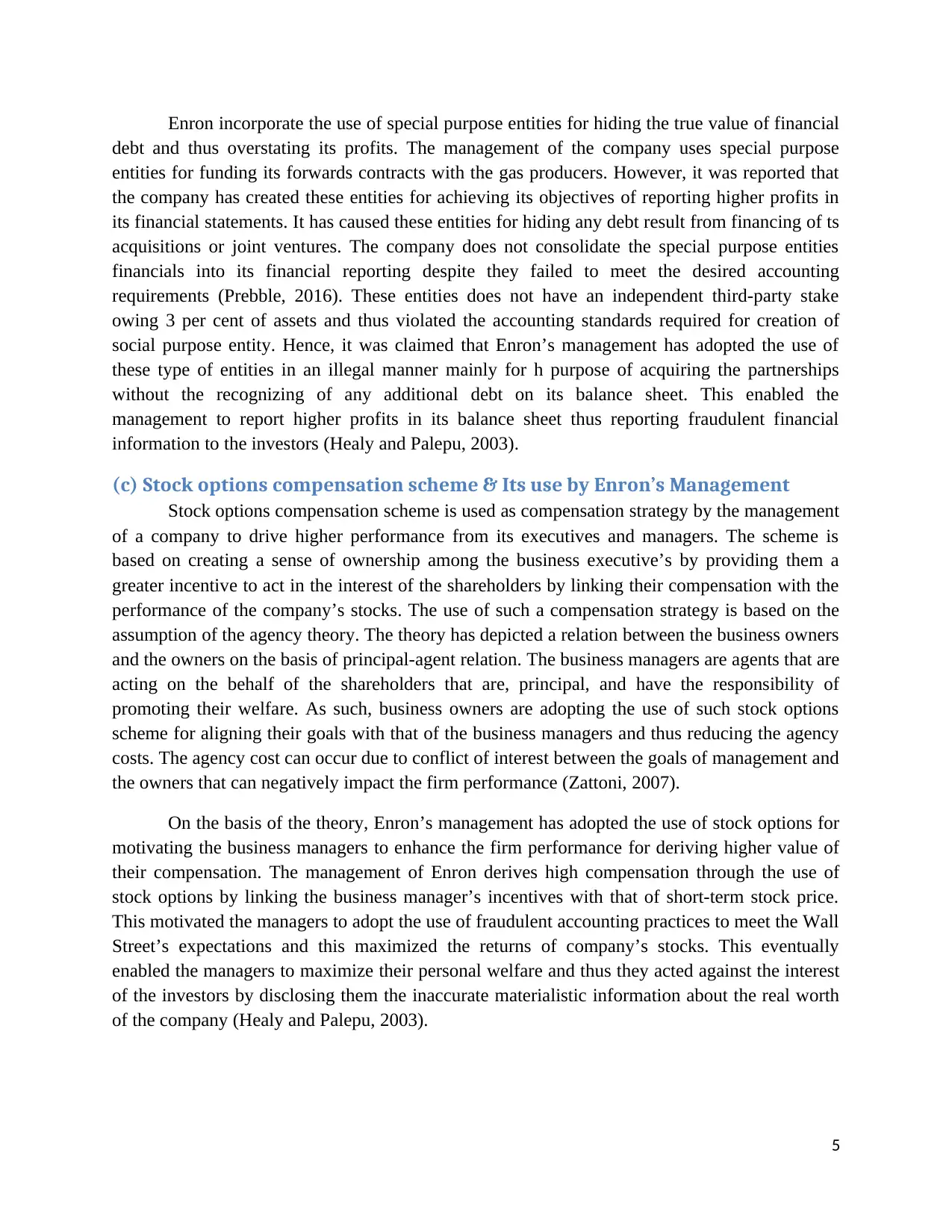
Enron incorporate the use of special purpose entities for hiding the true value of financial
debt and thus overstating its profits. The management of the company uses special purpose
entities for funding its forwards contracts with the gas producers. However, it was reported that
the company has created these entities for achieving its objectives of reporting higher profits in
its financial statements. It has caused these entities for hiding any debt result from financing of ts
acquisitions or joint ventures. The company does not consolidate the special purpose entities
financials into its financial reporting despite they failed to meet the desired accounting
requirements (Prebble, 2016). These entities does not have an independent third-party stake
owing 3 per cent of assets and thus violated the accounting standards required for creation of
social purpose entity. Hence, it was claimed that Enron’s management has adopted the use of
these type of entities in an illegal manner mainly for h purpose of acquiring the partnerships
without the recognizing of any additional debt on its balance sheet. This enabled the
management to report higher profits in its balance sheet thus reporting fraudulent financial
information to the investors (Healy and Palepu, 2003).
(c) Stock options compensation scheme & Its use by Enron’s Management
Stock options compensation scheme is used as compensation strategy by the management
of a company to drive higher performance from its executives and managers. The scheme is
based on creating a sense of ownership among the business executive’s by providing them a
greater incentive to act in the interest of the shareholders by linking their compensation with the
performance of the company’s stocks. The use of such a compensation strategy is based on the
assumption of the agency theory. The theory has depicted a relation between the business owners
and the owners on the basis of principal-agent relation. The business managers are agents that are
acting on the behalf of the shareholders that are, principal, and have the responsibility of
promoting their welfare. As such, business owners are adopting the use of such stock options
scheme for aligning their goals with that of the business managers and thus reducing the agency
costs. The agency cost can occur due to conflict of interest between the goals of management and
the owners that can negatively impact the firm performance (Zattoni, 2007).
On the basis of the theory, Enron’s management has adopted the use of stock options for
motivating the business managers to enhance the firm performance for deriving higher value of
their compensation. The management of Enron derives high compensation through the use of
stock options by linking the business manager’s incentives with that of short-term stock price.
This motivated the managers to adopt the use of fraudulent accounting practices to meet the Wall
Street’s expectations and this maximized the returns of company’s stocks. This eventually
enabled the managers to maximize their personal welfare and thus they acted against the interest
of the investors by disclosing them the inaccurate materialistic information about the real worth
of the company (Healy and Palepu, 2003).
5
debt and thus overstating its profits. The management of the company uses special purpose
entities for funding its forwards contracts with the gas producers. However, it was reported that
the company has created these entities for achieving its objectives of reporting higher profits in
its financial statements. It has caused these entities for hiding any debt result from financing of ts
acquisitions or joint ventures. The company does not consolidate the special purpose entities
financials into its financial reporting despite they failed to meet the desired accounting
requirements (Prebble, 2016). These entities does not have an independent third-party stake
owing 3 per cent of assets and thus violated the accounting standards required for creation of
social purpose entity. Hence, it was claimed that Enron’s management has adopted the use of
these type of entities in an illegal manner mainly for h purpose of acquiring the partnerships
without the recognizing of any additional debt on its balance sheet. This enabled the
management to report higher profits in its balance sheet thus reporting fraudulent financial
information to the investors (Healy and Palepu, 2003).
(c) Stock options compensation scheme & Its use by Enron’s Management
Stock options compensation scheme is used as compensation strategy by the management
of a company to drive higher performance from its executives and managers. The scheme is
based on creating a sense of ownership among the business executive’s by providing them a
greater incentive to act in the interest of the shareholders by linking their compensation with the
performance of the company’s stocks. The use of such a compensation strategy is based on the
assumption of the agency theory. The theory has depicted a relation between the business owners
and the owners on the basis of principal-agent relation. The business managers are agents that are
acting on the behalf of the shareholders that are, principal, and have the responsibility of
promoting their welfare. As such, business owners are adopting the use of such stock options
scheme for aligning their goals with that of the business managers and thus reducing the agency
costs. The agency cost can occur due to conflict of interest between the goals of management and
the owners that can negatively impact the firm performance (Zattoni, 2007).
On the basis of the theory, Enron’s management has adopted the use of stock options for
motivating the business managers to enhance the firm performance for deriving higher value of
their compensation. The management of Enron derives high compensation through the use of
stock options by linking the business manager’s incentives with that of short-term stock price.
This motivated the managers to adopt the use of fraudulent accounting practices to meet the Wall
Street’s expectations and this maximized the returns of company’s stocks. This eventually
enabled the managers to maximize their personal welfare and thus they acted against the interest
of the investors by disclosing them the inaccurate materialistic information about the real worth
of the company (Healy and Palepu, 2003).
5
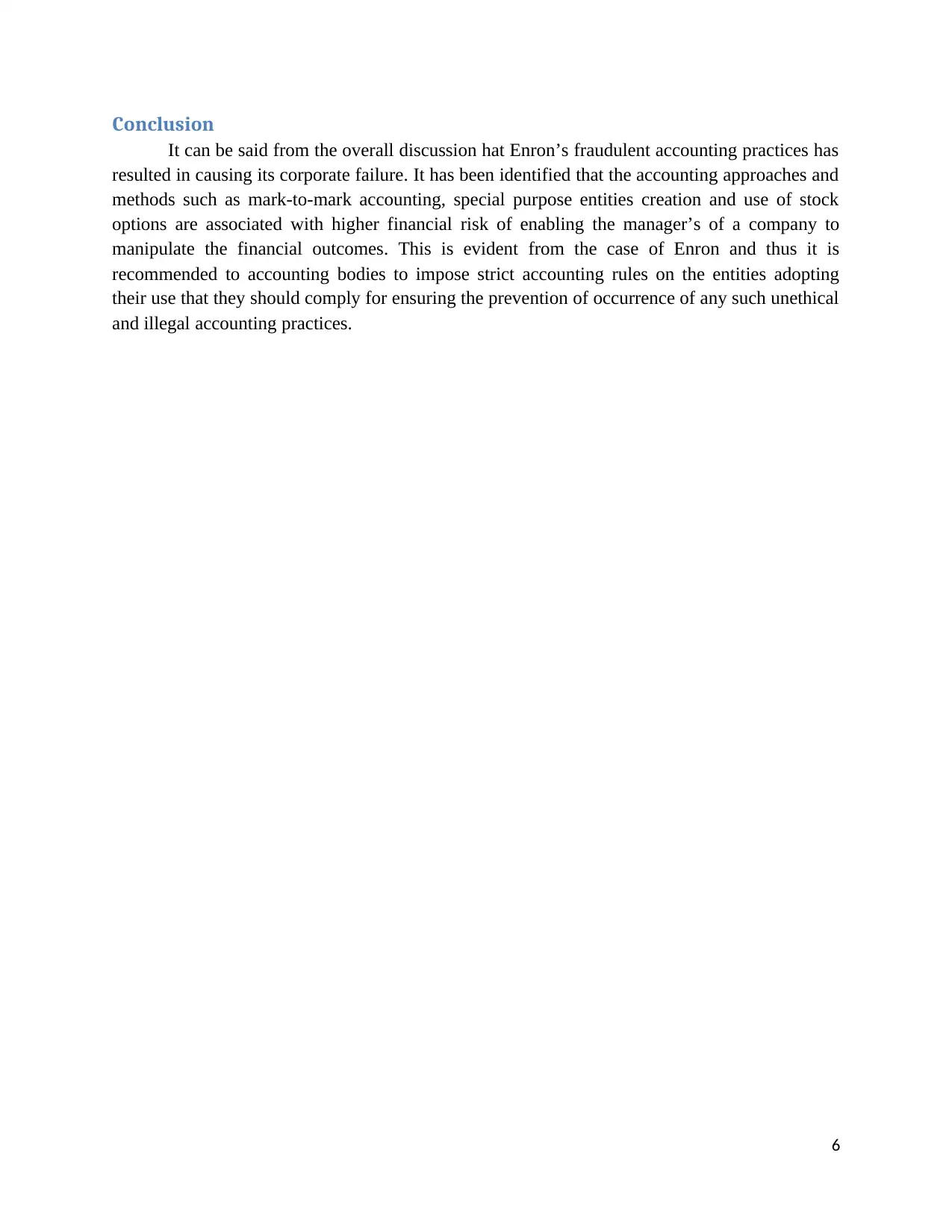
Conclusion
It can be said from the overall discussion hat Enron’s fraudulent accounting practices has
resulted in causing its corporate failure. It has been identified that the accounting approaches and
methods such as mark-to-mark accounting, special purpose entities creation and use of stock
options are associated with higher financial risk of enabling the manager’s of a company to
manipulate the financial outcomes. This is evident from the case of Enron and thus it is
recommended to accounting bodies to impose strict accounting rules on the entities adopting
their use that they should comply for ensuring the prevention of occurrence of any such unethical
and illegal accounting practices.
6
It can be said from the overall discussion hat Enron’s fraudulent accounting practices has
resulted in causing its corporate failure. It has been identified that the accounting approaches and
methods such as mark-to-mark accounting, special purpose entities creation and use of stock
options are associated with higher financial risk of enabling the manager’s of a company to
manipulate the financial outcomes. This is evident from the case of Enron and thus it is
recommended to accounting bodies to impose strict accounting rules on the entities adopting
their use that they should comply for ensuring the prevention of occurrence of any such unethical
and illegal accounting practices.
6
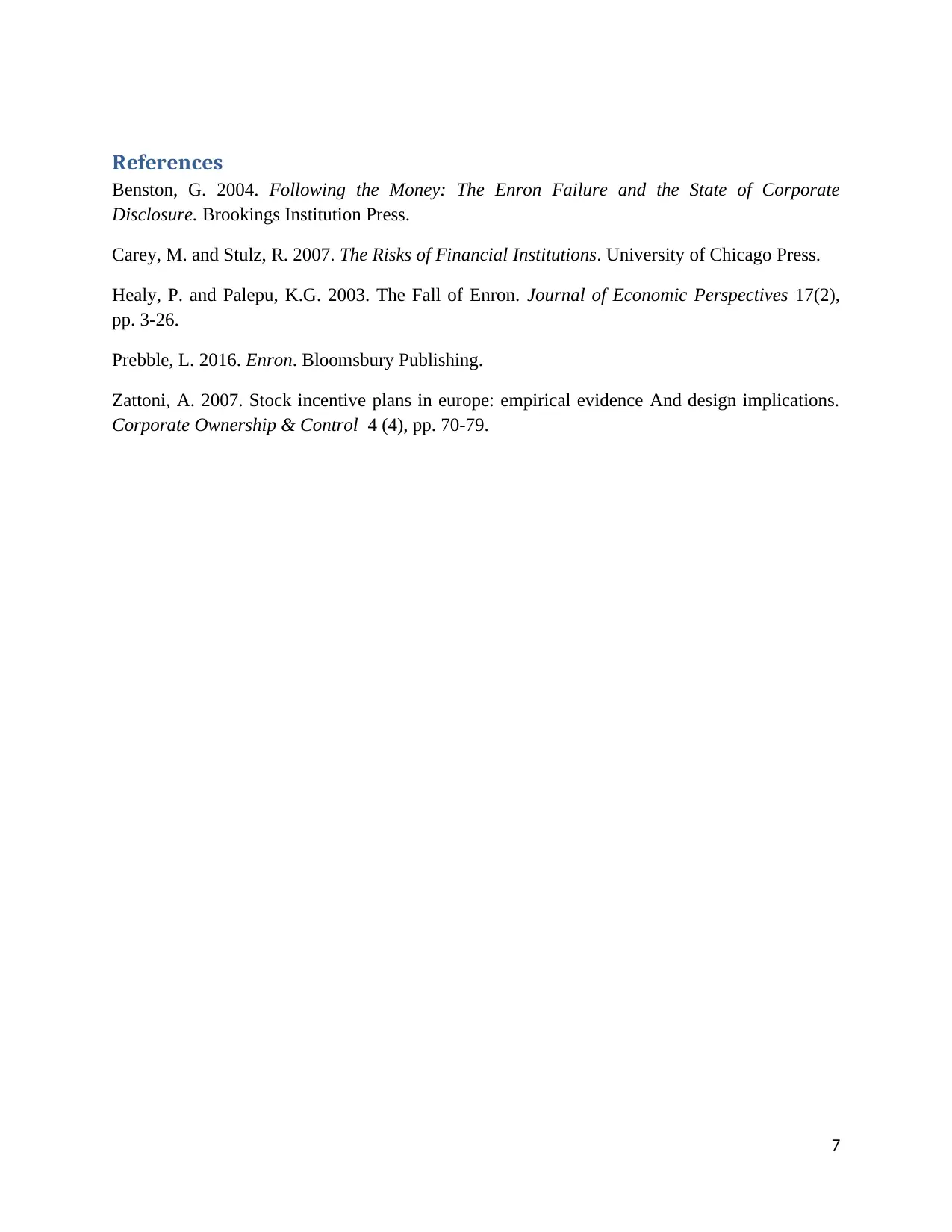
References
Benston, G. 2004. Following the Money: The Enron Failure and the State of Corporate
Disclosure. Brookings Institution Press.
Carey, M. and Stulz, R. 2007. The Risks of Financial Institutions. University of Chicago Press.
Healy, P. and Palepu, K.G. 2003. The Fall of Enron. Journal of Economic Perspectives 17(2),
pp. 3-26.
Prebble, L. 2016. Enron. Bloomsbury Publishing.
Zattoni, A. 2007. Stock incentive plans in europe: empirical evidence And design implications.
Corporate Ownership & Control 4 (4), pp. 70-79.
7
Benston, G. 2004. Following the Money: The Enron Failure and the State of Corporate
Disclosure. Brookings Institution Press.
Carey, M. and Stulz, R. 2007. The Risks of Financial Institutions. University of Chicago Press.
Healy, P. and Palepu, K.G. 2003. The Fall of Enron. Journal of Economic Perspectives 17(2),
pp. 3-26.
Prebble, L. 2016. Enron. Bloomsbury Publishing.
Zattoni, A. 2007. Stock incentive plans in europe: empirical evidence And design implications.
Corporate Ownership & Control 4 (4), pp. 70-79.
7
Paraphrase This Document
Need a fresh take? Get an instant paraphrase of this document with our AI Paraphraser
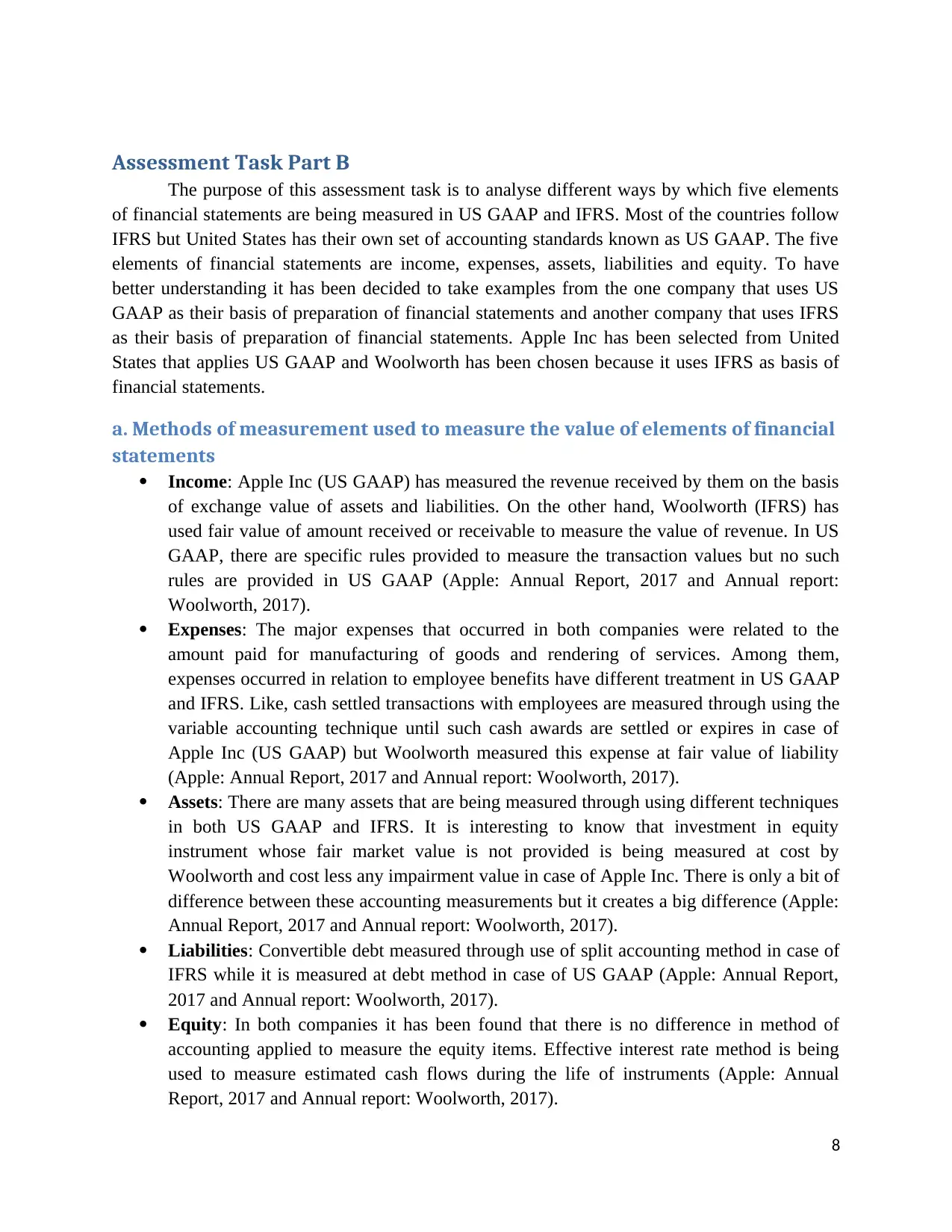
Assessment Task Part B
The purpose of this assessment task is to analyse different ways by which five elements
of financial statements are being measured in US GAAP and IFRS. Most of the countries follow
IFRS but United States has their own set of accounting standards known as US GAAP. The five
elements of financial statements are income, expenses, assets, liabilities and equity. To have
better understanding it has been decided to take examples from the one company that uses US
GAAP as their basis of preparation of financial statements and another company that uses IFRS
as their basis of preparation of financial statements. Apple Inc has been selected from United
States that applies US GAAP and Woolworth has been chosen because it uses IFRS as basis of
financial statements.
a. Methods of measurement used to measure the value of elements of financial
statements
Income: Apple Inc (US GAAP) has measured the revenue received by them on the basis
of exchange value of assets and liabilities. On the other hand, Woolworth (IFRS) has
used fair value of amount received or receivable to measure the value of revenue. In US
GAAP, there are specific rules provided to measure the transaction values but no such
rules are provided in US GAAP (Apple: Annual Report, 2017 and Annual report:
Woolworth, 2017).
Expenses: The major expenses that occurred in both companies were related to the
amount paid for manufacturing of goods and rendering of services. Among them,
expenses occurred in relation to employee benefits have different treatment in US GAAP
and IFRS. Like, cash settled transactions with employees are measured through using the
variable accounting technique until such cash awards are settled or expires in case of
Apple Inc (US GAAP) but Woolworth measured this expense at fair value of liability
(Apple: Annual Report, 2017 and Annual report: Woolworth, 2017).
Assets: There are many assets that are being measured through using different techniques
in both US GAAP and IFRS. It is interesting to know that investment in equity
instrument whose fair market value is not provided is being measured at cost by
Woolworth and cost less any impairment value in case of Apple Inc. There is only a bit of
difference between these accounting measurements but it creates a big difference (Apple:
Annual Report, 2017 and Annual report: Woolworth, 2017).
Liabilities: Convertible debt measured through use of split accounting method in case of
IFRS while it is measured at debt method in case of US GAAP (Apple: Annual Report,
2017 and Annual report: Woolworth, 2017).
Equity: In both companies it has been found that there is no difference in method of
accounting applied to measure the equity items. Effective interest rate method is being
used to measure estimated cash flows during the life of instruments (Apple: Annual
Report, 2017 and Annual report: Woolworth, 2017).
8
The purpose of this assessment task is to analyse different ways by which five elements
of financial statements are being measured in US GAAP and IFRS. Most of the countries follow
IFRS but United States has their own set of accounting standards known as US GAAP. The five
elements of financial statements are income, expenses, assets, liabilities and equity. To have
better understanding it has been decided to take examples from the one company that uses US
GAAP as their basis of preparation of financial statements and another company that uses IFRS
as their basis of preparation of financial statements. Apple Inc has been selected from United
States that applies US GAAP and Woolworth has been chosen because it uses IFRS as basis of
financial statements.
a. Methods of measurement used to measure the value of elements of financial
statements
Income: Apple Inc (US GAAP) has measured the revenue received by them on the basis
of exchange value of assets and liabilities. On the other hand, Woolworth (IFRS) has
used fair value of amount received or receivable to measure the value of revenue. In US
GAAP, there are specific rules provided to measure the transaction values but no such
rules are provided in US GAAP (Apple: Annual Report, 2017 and Annual report:
Woolworth, 2017).
Expenses: The major expenses that occurred in both companies were related to the
amount paid for manufacturing of goods and rendering of services. Among them,
expenses occurred in relation to employee benefits have different treatment in US GAAP
and IFRS. Like, cash settled transactions with employees are measured through using the
variable accounting technique until such cash awards are settled or expires in case of
Apple Inc (US GAAP) but Woolworth measured this expense at fair value of liability
(Apple: Annual Report, 2017 and Annual report: Woolworth, 2017).
Assets: There are many assets that are being measured through using different techniques
in both US GAAP and IFRS. It is interesting to know that investment in equity
instrument whose fair market value is not provided is being measured at cost by
Woolworth and cost less any impairment value in case of Apple Inc. There is only a bit of
difference between these accounting measurements but it creates a big difference (Apple:
Annual Report, 2017 and Annual report: Woolworth, 2017).
Liabilities: Convertible debt measured through use of split accounting method in case of
IFRS while it is measured at debt method in case of US GAAP (Apple: Annual Report,
2017 and Annual report: Woolworth, 2017).
Equity: In both companies it has been found that there is no difference in method of
accounting applied to measure the equity items. Effective interest rate method is being
used to measure estimated cash flows during the life of instruments (Apple: Annual
Report, 2017 and Annual report: Woolworth, 2017).
8
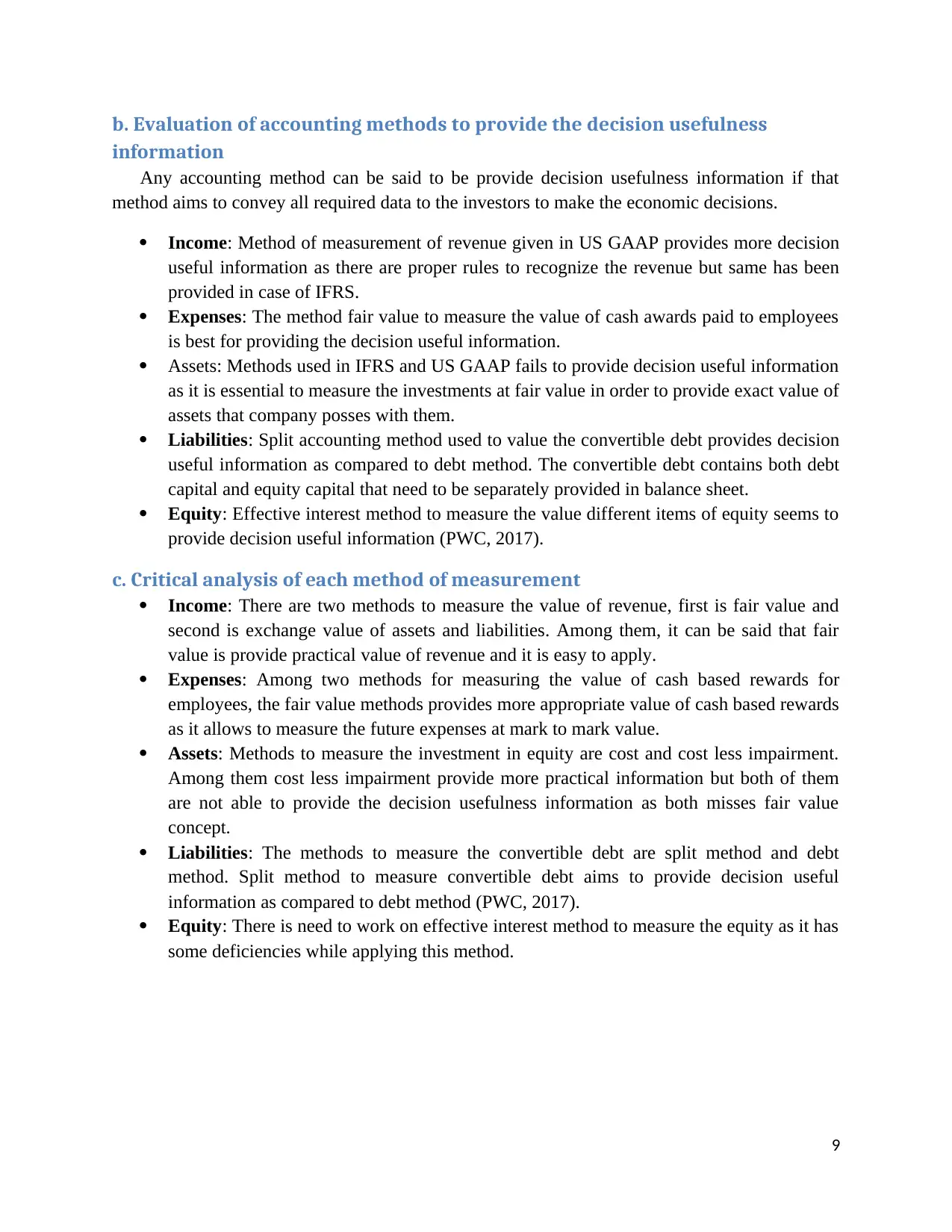
b. Evaluation of accounting methods to provide the decision usefulness
information
Any accounting method can be said to be provide decision usefulness information if that
method aims to convey all required data to the investors to make the economic decisions.
Income: Method of measurement of revenue given in US GAAP provides more decision
useful information as there are proper rules to recognize the revenue but same has been
provided in case of IFRS.
Expenses: The method fair value to measure the value of cash awards paid to employees
is best for providing the decision useful information.
Assets: Methods used in IFRS and US GAAP fails to provide decision useful information
as it is essential to measure the investments at fair value in order to provide exact value of
assets that company posses with them.
Liabilities: Split accounting method used to value the convertible debt provides decision
useful information as compared to debt method. The convertible debt contains both debt
capital and equity capital that need to be separately provided in balance sheet.
Equity: Effective interest method to measure the value different items of equity seems to
provide decision useful information (PWC, 2017).
c. Critical analysis of each method of measurement
Income: There are two methods to measure the value of revenue, first is fair value and
second is exchange value of assets and liabilities. Among them, it can be said that fair
value is provide practical value of revenue and it is easy to apply.
Expenses: Among two methods for measuring the value of cash based rewards for
employees, the fair value methods provides more appropriate value of cash based rewards
as it allows to measure the future expenses at mark to mark value.
Assets: Methods to measure the investment in equity are cost and cost less impairment.
Among them cost less impairment provide more practical information but both of them
are not able to provide the decision usefulness information as both misses fair value
concept.
Liabilities: The methods to measure the convertible debt are split method and debt
method. Split method to measure convertible debt aims to provide decision useful
information as compared to debt method (PWC, 2017).
Equity: There is need to work on effective interest method to measure the equity as it has
some deficiencies while applying this method.
9
information
Any accounting method can be said to be provide decision usefulness information if that
method aims to convey all required data to the investors to make the economic decisions.
Income: Method of measurement of revenue given in US GAAP provides more decision
useful information as there are proper rules to recognize the revenue but same has been
provided in case of IFRS.
Expenses: The method fair value to measure the value of cash awards paid to employees
is best for providing the decision useful information.
Assets: Methods used in IFRS and US GAAP fails to provide decision useful information
as it is essential to measure the investments at fair value in order to provide exact value of
assets that company posses with them.
Liabilities: Split accounting method used to value the convertible debt provides decision
useful information as compared to debt method. The convertible debt contains both debt
capital and equity capital that need to be separately provided in balance sheet.
Equity: Effective interest method to measure the value different items of equity seems to
provide decision useful information (PWC, 2017).
c. Critical analysis of each method of measurement
Income: There are two methods to measure the value of revenue, first is fair value and
second is exchange value of assets and liabilities. Among them, it can be said that fair
value is provide practical value of revenue and it is easy to apply.
Expenses: Among two methods for measuring the value of cash based rewards for
employees, the fair value methods provides more appropriate value of cash based rewards
as it allows to measure the future expenses at mark to mark value.
Assets: Methods to measure the investment in equity are cost and cost less impairment.
Among them cost less impairment provide more practical information but both of them
are not able to provide the decision usefulness information as both misses fair value
concept.
Liabilities: The methods to measure the convertible debt are split method and debt
method. Split method to measure convertible debt aims to provide decision useful
information as compared to debt method (PWC, 2017).
Equity: There is need to work on effective interest method to measure the equity as it has
some deficiencies while applying this method.
9
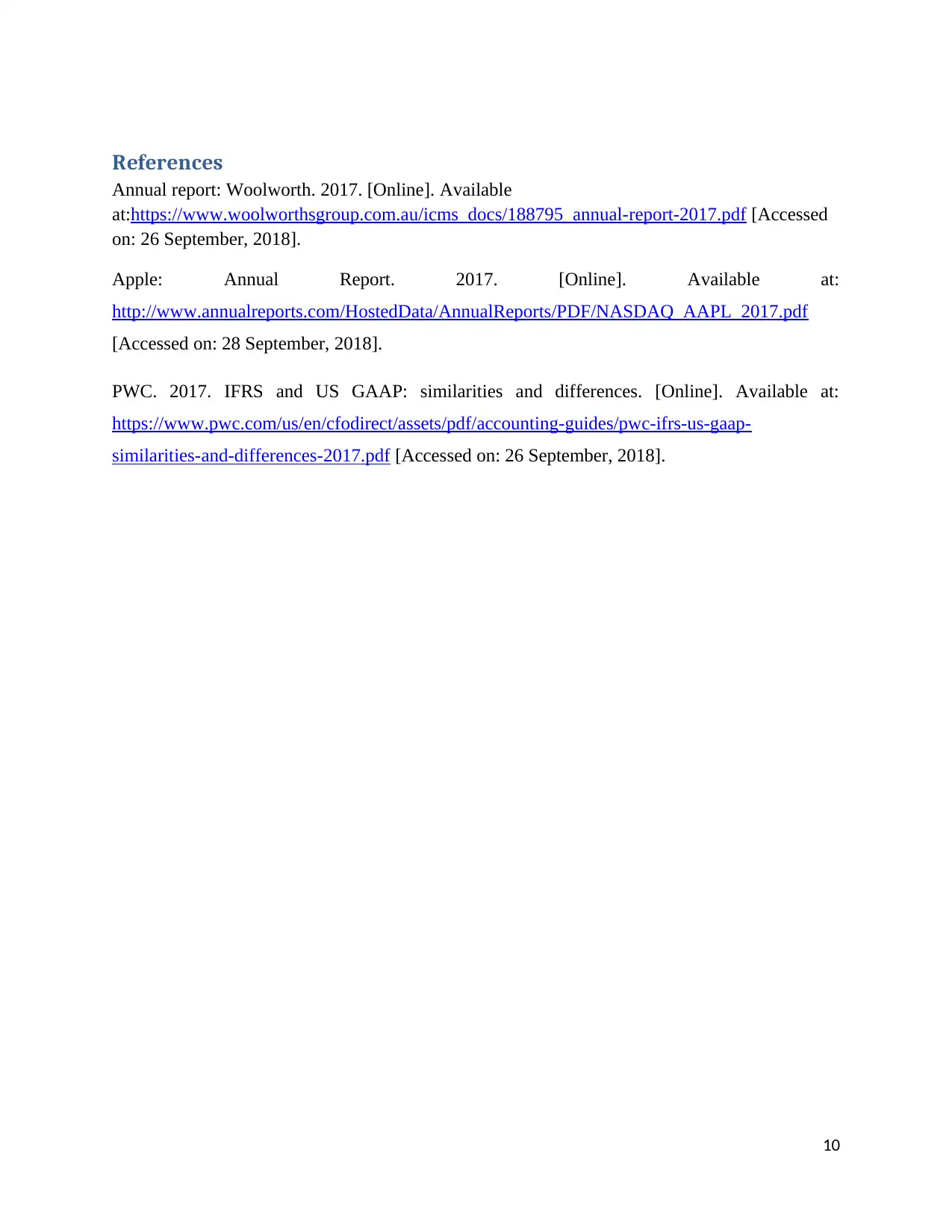
References
Annual report: Woolworth. 2017. [Online]. Available
at:https://www.woolworthsgroup.com.au/icms_docs/188795_annual-report-2017.pdf [Accessed
on: 26 September, 2018].
Apple: Annual Report. 2017. [Online]. Available at:
http://www.annualreports.com/HostedData/AnnualReports/PDF/NASDAQ_AAPL_2017.pdf
[Accessed on: 28 September, 2018].
PWC. 2017. IFRS and US GAAP: similarities and differences. [Online]. Available at:
https://www.pwc.com/us/en/cfodirect/assets/pdf/accounting-guides/pwc-ifrs-us-gaap-
similarities-and-differences-2017.pdf [Accessed on: 26 September, 2018].
10
Annual report: Woolworth. 2017. [Online]. Available
at:https://www.woolworthsgroup.com.au/icms_docs/188795_annual-report-2017.pdf [Accessed
on: 26 September, 2018].
Apple: Annual Report. 2017. [Online]. Available at:
http://www.annualreports.com/HostedData/AnnualReports/PDF/NASDAQ_AAPL_2017.pdf
[Accessed on: 28 September, 2018].
PWC. 2017. IFRS and US GAAP: similarities and differences. [Online]. Available at:
https://www.pwc.com/us/en/cfodirect/assets/pdf/accounting-guides/pwc-ifrs-us-gaap-
similarities-and-differences-2017.pdf [Accessed on: 26 September, 2018].
10
Secure Best Marks with AI Grader
Need help grading? Try our AI Grader for instant feedback on your assignments.

11

12
1 out of 12
Related Documents
Your All-in-One AI-Powered Toolkit for Academic Success.
+13062052269
info@desklib.com
Available 24*7 on WhatsApp / Email
![[object Object]](/_next/static/media/star-bottom.7253800d.svg)
Unlock your academic potential
© 2024 | Zucol Services PVT LTD | All rights reserved.




